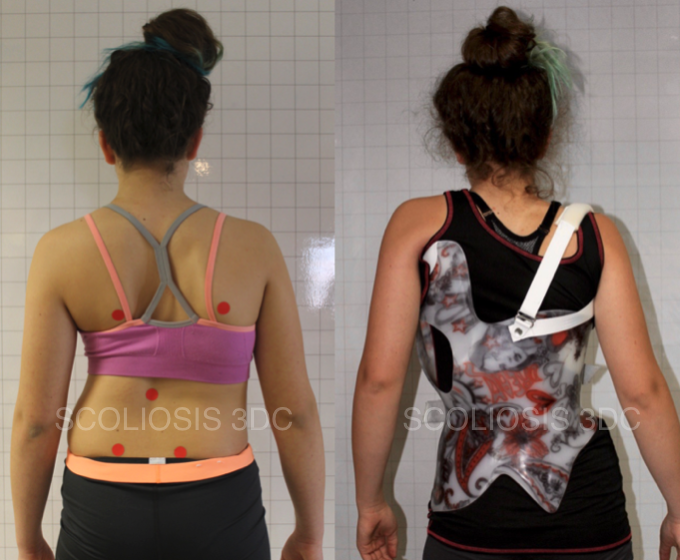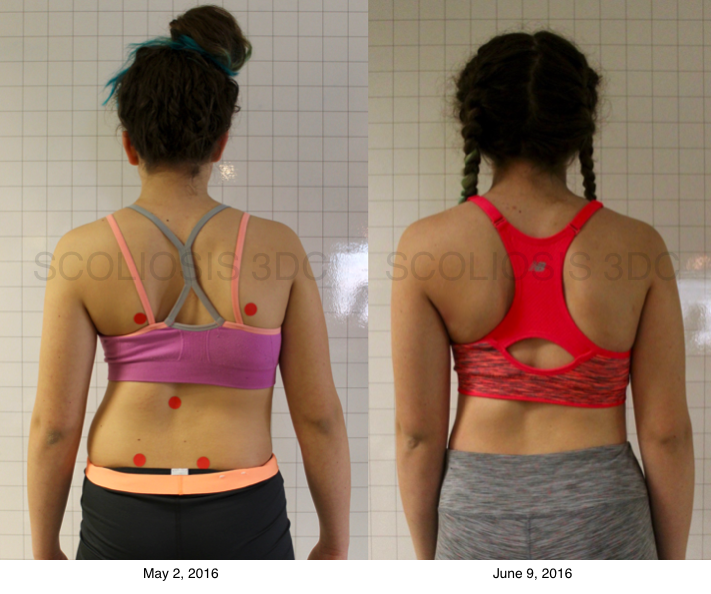Let’s face it, few scoliosis patients willingly choose fusion surgery. However, it’s often the only option presented when Cobb angles are 45º or 50º, or greater. Here’s the story of one girl’s quest for a brace to avoid scoliosis surgery.
Who wouldn’t prefer an effective conservative treatment option over what one spine surgeon refers to as, “a grueling operation”? However, in most instances, parents are rarely informed of their range of choices–from various bracing options to curve-specific exercise rehabilitation. Patients with moderately severe curves are often told bracing is ineffective and that this conservative method cannot be used to avoid scoliosis surgery. Now, that’s simply not true.
Mixed messaging regarding scoliosis is everywhere–online, in forums and from physicians as well. This results in stress and confusion for parents, kids, and adult patients, too.
One of our patient’s scoliosis story (so far!) illustrates what happens when that confusion ensues.
Her scoliosis was detected by her pediatrician more than two years ago with the recommendation to ‘monitor’ her back. Her mom told us that late last fall her daughter was finally officially diagnosed. Her Cobb angles measured 47º and 35°. At that time, they met with an orthopedic surgeon and mom specifically asked about exercise for scoliosis. The doctor’s response: she had “investigated it but never saw any benefits,” so her recommendation was for bracing with the hope of stopping progression.
Our patient’s mom decided to seek help, on her own. In early March, mom found a Schroth therapist local to their area (Philadelphia, Pennsylvania). (We have since trained an excellent Philadelphia Schroth practitioner in Schroth Best Practice!) When they asked the practitioner she was seeing about bracing she told them that her patients most often used the Wilmington brace (it’s also the one their orthopedic doctor recommended) or another Cheneau brace. Mom decided to call the hospital for the Wilmington brace. She was told she couldn’t get an appointment for months (Don’t the people at that hospital know that scoliosis doesn’t wait?).
Wanting to be proactive, mom decided to call another bracing practitioner who makes his own version of a Rigo brace. They got an appointment and traveled for a consult in late March. At the appointment they were informed that the girl wasn’t eligible for bracing based on the magnitude of her curves. She was told that she “needed surgery.” The girl was extremely dejected as she wanted to avoid scoliosis surgery.
Mom told us, “On our 3 hour drive home, the hospital that offers the Wilmington brace called to see if we still wanted our appointment. I explained our rejection of a few short hours ago and questioned if they would be able to brace her.” The response from the hospital employee was, “Of course, we brace all degrees.” (This is not at all true in mainstream medicine, they were misinformed).
Mom continued, “We waited and finally had an appointment [end of April]. You cannot imagine our shock when [after her casting x-ray] my daughter was told once again that she cannot be braced and you need to meet with an orthopedic doctor immediately. We left there in the early afternoon with no brace after an hour of an orthopedic doctor telling her that her only option is surgery.”
Feeling completely defeated, the patient’s mom returned home and emailed us. In that email she explained, “I had found your site in December when we were first confronted with this. At that time we couldn’t absorb taking her out of school for that time period.” In the interim, however, the scoliosis had progressed to 64º thoracic and 41º lumbar.
Mom made an appointment to come up to Boston within a couple of weeks to have her daughter fitted for the Gensingen brace. Before making the trip though, she wanted guarantees we would brace her daughter. We assured her (but would not guarantee) that we’d brace her if, upon examination, there were no extenuating circumstances as she had indicated.
Fortunately, we were able to provide the Gensingen brace for this girl. As you can see in the photos, the Cheneau-Gensingen brace puts the spine in a more corrected position.

While here to be fit for her brace she began our Schroth Best Practice® program – it differs significantly from what other Schroth therapists teach. She returned a month later to complete her program and was already showing visible postural improvement!

This girl’s scoliosis story illustrates so many of the points we regularly try to drive home to parents of kids with idiopathic scoliosis! Take the right steps to prevent scoliosis progression and avoid scoliosis surgery, as soon as possible. Doing so will allow your family a smoother scoliosis journey. We aren’t promising it will be stress free but we are here to guide you through the process! Don’t be afraid to look “outside the box” for the most innovative approaches with evidence to back it up.
Tips to avoid scoliosis surgery and manage the curve(s)
- Time is of the essence when it comes to scoliosis management (we know we state this over and over but it bears repeating)!
- DO NOT wait and see when scoliosis is first diagnosed, especially if your child is at a significant risk of progression.
- The Cheneau Gensingen Brace® addresses all degrees of scoliosis curves, even severe scoliosis – which is almost always recommended for surgery. This includes curves with Cobb angles of 60º and higher.
- Surgery is not the only option when the curves reach 45º, 50º or 55º. The Gensingen Brace® offers the chance for postural improvement, and perhaps Cobb angle improvement, without surgery.
- Choose the brace your child is fit for wisely. Most braces don’t have a record of influencing large magnitude curves.
- If you’re not happy with the way your child’s scoliosis is being managed, follow your instincts before too much time passes. Be willing to travel for the best scoliosis care. As time goes on there is less chance of effecting change. (When only residual growth remains, the Gensingen Brace® can often still help with posture).
If you follow us online, you are probably aware of the numerous benefits of the Gensingen Brace®. Its 3D, asymmetric design focuses on overcorrection. The truth is that today most scoliosis braces prescribed, even by the most esteemed physicians, are dated. Most surgeons, like the one our patient saw, still continue to resist change.
It’s up to parents to consider the big picture and the potential negatives that can last a lifetime when progression occurs. As our patient’s mom came to understand, a few days of missed school is inconsequential in the big scheme of things. Every child deserves the best care and treatment options for scoliosis. When it comes to managing spinal curvature(s), it’s up to you to forge your child’s best path and establish a framework for success.

